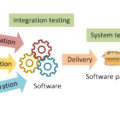Podcast: Play in new window | Download (Duration: 31:38 — 22.0MB)
Subscribe: Apple Podcasts | Google Podcasts | Spotify | Stitcher | Podchaser | Email | TuneIn | RSS
In this episode we talk about Azure Pipelines.
Definitions
-
What is a pipeline
- Chain of repeatable actions/tasks that transform some input into some output. Its like a function chain.
-
Types of pipelines
- Build Pipeline
- This pipeline takes the source code as input and produces deployable artifacts as the output.
- It may also do some unit testing, linting and static analysis to the code to check the validatiy of the output artifacts.
- Release Pipleline
- This pipeline takes the deployable artifacts as input and produces deployed environments as outputs.
- It may also perform some automated integration tests to test the validity of the deployment
- Build Pipeline
-
Continuous Integration (CI)
- This is the practice of merging the small batches of developer changes into the main branch continuously instead of all at once at the end of a development cycle.
- This is facilitated by a good build pipeline.
- For good or worse CI Pipeline and Build Pipeline are often conflated
-
Continuous Delivery (CD)
- This is the practice of automatically deploying an artifact to an environment as soon as the artifact is created.
- This does not mean that the environment production.
- This is facilitated by a good release pipeline
- For good or worse CD Pipeline and Release Pipeline are often conflated
-
CI/CD
- This is when we combine the practice of Continuous Integration with the practice of Continuous Delivery
-
Continuous Deployment
- This is the practice of extending the automatic deployment of an artifact through all stages until is automatically deployed to production.
- This requires one or more good release pipelines
- It often gets confused with Continious Delivery. It is Continuous Delivery but Continuous Delivery is not Continuous Deployment.
Azure DevOps Products
- Azure DevOps
- A suite of development tools
- Azure Pipelines
- Tool for building out the build and release pipelines
- Alternates Jenkins, Octopus, TeamCity, Circleci, GitLab
- Excellent GitHub and Azure DevOps Repos integration, but can connect to other remote repositories
- Excellent Azure integration, but can deploy into most any platfor or environment.
- Linux, macOS and Windows adjents
- Supports most lanuages
- Free for Open Source (10 parallel jobs unlimited minutes)
- First agent free for closed source
Before Creating a Pipeline
- Consider your branching strategy
- Recommend, Trunk-based Strategy
- Team shares single trunk (master) that all development is based off of.
- Release Flow
- Recommend, Trunk-based Strategy
Creating a Build Pipeline
-
YAML vs Classic
- Recommend, YAML uses a yaml config stored in the source code repository to define the build pipeline.
- Classic is good for learning the platform and can be used to figure out the correct yaml.
-
trigger
- Recommend, based on changes to specified branchs
- can include or exclude files and folders within the branch
- can be triggered on a timed schedule
- Recommend, based on changes to specified branchs
-
define jobs
- a job us run on an agent and has its own variables and copies of source code etc.
- jobs can be completed in parallel
-
define steps in jobs
- steps are the collection of steps/tasks that a given job will run
-
define the task in step
- each step is a task
- this will be the heart of your build pipeline and will depend largely on what you are building
-
variables
- you may want to specify some variables across jobs, like version number
-
pools
- you many want to specify the type of agent to use by default instead of in every job definition
Creating a Release Pipeline
-
Classic
- The “only released” method for creating a release pipeline is the classic method
- You could create a yaml build pipeline that performed the release tasks but triggers might be more challenging.
- Recommend, There are some other options in pre-release.
-
select artifacts
- this will likely come from artifacts published from a build pipeline
-
define (release) trigger
- recommend, set continuous when an artifact is avaible
- can be triggered on a timed schedule
-
define a stage
- define (stage) trigger
- define stage tasks
- this is the heart of your release pipeline and will depend largely on what you are deploying to
-
Classic stores your release definition in a source control but not managed by you.
-
Think of every environment as a stage
-
Releases are created but that does not mean the artifacts are deployed to an environment. The stage completes that deployment to the environment
-
If you change the release pipeline definition you will need to create a new release to follow the new changes
Multi-Stage Pipeline
-
Pre-release feature, well supported and pretty feature full but not complete
-
GearGuy (next to login avatar) > Preview Features > Multi-stage pipelines
-
This combines your build and release pipelines
-
They are all defined by a single yaml config in your source code repo
-
Follow similar steps to building a deployment pipeline however, add stages.
-
usually the entire build pipeline would be contained within a single stage
-
then just like in classic release pipelines each environment would be a stage.
-
the same job, steps, tasks organization exists within every stage
-
the heart of every stage is at the task level
-
A release is created every time pipeline is triggered (likely every code change)
-
stages can be rerun within a given release
Resources
https://azure.microsoft.com/en-in/overview/continuous-delivery-vs-continuous-deployment/
https://trunkbaseddevelopment.com/
https://docs.microsoft.com/en-us/azure/devops/learn/devops-at-microsoft/release-flow
https://docs.microsoft.com/en-us/azure/devops/pipelines/process/tasks?view=azure-devops&tabs=yaml
https://docs.microsoft.com/en-us/azure/devops/pipelines/?view=azure-devops
“Tempting Time” by Animals As Leaders used with permissions – All Rights Reserved
An International Speaker, Author, and Microsoft MVP, John has been a professional developer since 1999. He has focused primarily on web technologies and currently focuses on C# and .NET Core in Azure. Clean code and professionalism are particularly important to him, as well as mentoring and teaching others what he has learned along the way.









